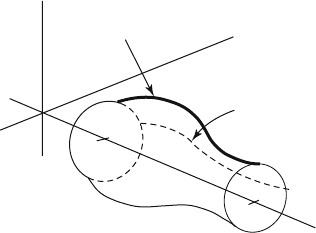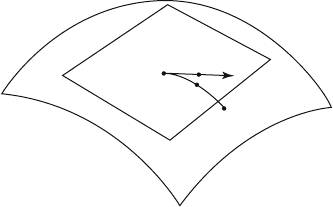Agoston M.K. Computer Graphics and Geometric Modelling: Mathematics
Подождите немного. Документ загружается.


and
The vector F
t
¥F
q
is a surface normal. Although it may not have unit length, using
it in formulas, as we shall do, rather than a normalized version will simplify expres-
sions but not change the validity of when certain dot products are zero.
Consider the meridian
and its derivatives
It is easy to check that
and so a(t) is a geodesic by the theorems mentioned.
Next, consider the circle of latitude
and its derivatives
This time
bb
q
≤∑ ¥
()
¥¢
()
=¢FF
t
yy
3
.
bq q q
bq q q
¢
()
=-
() ()()
≤
()
=-
()
-
()()
0
0
, sin , cos
, cos , sin .
yt yt
yt yt
bq q
()
=
()
F t,
aa
q
≤∑ ¥
()
¥¢
()
=FF
t
0,
aqq
aqq
¢
()
=¢
()
¢
()
¢
()()
≤
()
=≤
()
≤
()
≤
()()
txtyt yt
txtyt yt
, cos , sin
, cos , sin
aqtt
()
=
()
F ,
FF
t
t t ytyt xt xt, , , cos , sin .qq q q
q
()
¥
()
=
()
¢
()
-¢
()
-¢
()()
9.10 Geodesics 629
z
meridian
y
a
b
x
h(t)=(x(t),y(t))
Figure 9.27. Geodesics on a surface of
revolution.
But y π 0 because the curve h(t) does not cross the x-axis, and so this expression will
vanish if and only if y¢=0. This is equivalent to saying that F
t
(t,q) = (x¢(t),0,0), which
is what we were trying to show.
As an application, consider the torus and its parameterization as defined in
Example 9.9.18. We can think of this torus as a surface of revolution where the curve
gets revolved about the x-axis. It is clear that the meridians, which are circles in this
case, are geodesics. On the other hand, y¢(t) = cost = 0 implies that t =p/2 or 3p/2. In
other words, the only circles of latitude that are geodesics are the inner circle with
radius R - r and the outer circle with radius R + r.
Our definition of geodesic applied only to surfaces in R
3
because we made use
of the normal vectors to the surface. Obviously, the normal curvature of a curve
depends on having a normal vector, but it turns out that its geodesic curvature does
not.
9.10.10. Theorem. (Minding) The geodesic curvature of a curve in a surface is a
metric invariant.
Proof. Specifically, what we want to show is that the geodesic curvature depends
only on the curve and the metric coefficients of the surface. How the surface is
imbedded in R
3
plays no role.
Let
be a regular one-to-one parameterization of a surface S in R
3
and let n(p) be the unit
normal vector to the surface S at the point p. Let
be a curve parameterized by arc-length. Express g in the form g(s) =F(m(s)),
where
Now
(9.69)
and
(9.70)
Substituting the right-hand side of equations (9.58) for the F
uu
, F
uv
, and F
vv
in equa-
tion (9.70) gives
g≤= ¢ + ¢ ¢+ ¢ + ≤+ ≤FFFFF
uu uv vv u v
uuvvuv
22
2.
g¢= ¢+ ¢FF
uv
uv
mm:, , .a b and s u s v s
[]
Æ
()
=
() ()()
R
2
g :,ab
[]
Æ S
F : USÆ
h t RrtrtrtRrtxtyt
()
=
()
+
()
=+
()
=
() ()()
0, cos , sin cos , sin ,
630 9 Differential Geometry

so that equation (9.65) clearly implies that
To make the pattern more apparent, we change our notation slightly and rename our
parameters u and v to x
1
and x
2
, respectively, so that we can rewrite the last equation
using summation notation as
(9.71)
(F
1
and F
2
are the partials F
u
and F
v
, respectively.) But, using Equation (9.69),
Therefore, if we let c
km
= n •(F
k
¥F
m
), then
Finally, since
we have shown that k
g
depends only on the Christoffel symbols, which are metric
invariants by equation (9.59), and g. The theorem is proved.
Moving on to property (2) of straight lines, we can see from Example 9.10.8 that
a geodesic in S
2
, as we have defined one, can start at a point, go round and round a
great circle, and finally end up at that point again, so that it is not necessarily the
shortest curve between any two points. On the other hand, they do satisfy property
(2) locally. One can prove the following:
9.10.11. Theorem. Let S be a surface in R
3
. Let h:[a,b] Æ S be a regular curve.
(1) If h(t) is a geodesic, then there is an e>0 with the property that if |s
1
- s
2
|
<ethen g|[s
1
,s
2
] is a curve of shortest length from g(s
1
) to g(s
2
).
(2) If h(t) is a curve of shortest length from h(a) to h(b), then h(t) is a geodesic.
c c and c c g
11 22 12 21
0== =-=,
kk
gg k
ij
k
i
ij
jk
k
k
ij
k
ij
ijkm
kkm
nn x xx n
xxxxc
=
()
∑= ¢¢+ ¢¢
È
Î
Í
˘
˚
˙
Ê
Ë
Á
ˆ
¯
˜
∑
=¢¢+¢¢
È
Î
Í
˘
˚
˙
¢
Ê
Ë
Á
ˆ
¯
˜
==
==
ÂÂ
ÂÂ
SS S
GF
G
,
,,
.
1
2
1
2
1
2
1
2
nx
m
m
mS
nn=¥¢= ¢ ¥
=
Â
g
1
2
F .
k
gk
ij
k
ij
ijk
k
nx xx
S
=¢¢+ ¢¢
È
Î
Í
˘
˚
˙
==
ÂÂ
GF
,
.
1
2
1
2
k
guv
nu u uv v v u uv v
S
=≤+ ¢+ ¢¢+ ¢
[]
+≤+ ¢+ ¢¢+ ¢
[]
GGGFGGGF
11
12
12
1
22
12
11
22
12
2
22
22
22.
g≤= ¢ + ¢ ¢+ ¢
[]
+≤+ ¢+ ¢¢+ ¢
[]
+≤+ ¢+ ¢¢+ ¢
[]
Lu Mu v Nv
uu uvv vu uvv
uv
22
11
12
12
1
22
12
11
22
12
2
22
22
2
22
n
G G GF G G GF,
9.10 Geodesics 631
Proof. For a proof of (1) using the exponential map which is defined later in this
section see [Thor79]. For (2) see [MilP77].
Theorem 9.10.11 implies that the first definition of a geodesic is equivalent to the
following one:
Third definition of a geodesic: A geodesic on a surface S in R
3
is just a regular
curve in S that has the property that locally it defines a curve of shortest length.
Moving on to property (3) of straight lines, it is easy to give examples that show
geodesics are neither unique nor exist in general. For example, there are an infinite
number of (in fact, minimal-length) geodesics between antipodal points on a sphere
and the surface R
2
-0 (a punctured plane) has no geodesic from (-1,0) to (1,0) (there
exist curves between the two points with length arbitrarily close to 2 but none of length
exactly 2). Although there may not be a geodesic between an arbitrary pair of points,
geodesics do exist if the points are not too far apart. The proof of this fact will also
show that finding geodesics is simply a matter of solving second order differential
equations.
9.10.12. Theorem. Let S be a surface in R
3
. Let p ΠS and v ΠT
p
(S), v π 0. Then
there is an e>0 and a unique constant speed geodesic g:(-e,e) Æ S with g(0) = p and
g¢(0) = v. (For v = 0, the unique “geodesic” would be the constant curve g(t) = p.)
Sketch of two proofs. For the first proof, we use a regular parameterization F of
a neighborhood of p in S and equation (9.71). Since we are looking for a geodesic,
the left-hand side of the equation vanishes. But the partials F
1
and F
2
are linearly
independent, being a basis of the tangent space. It follows that any solution g must
satisfy the equations
(9.72)
Conversely, one can show that any such solution satisfying our initial conditions will
solve our problem, namely, it must be a constant speed curve. One only has to appeal
to theorems about the existence and uniqueness of solutions to differential equations
to finish the proof. See [MilP77].
The proof we just sketched shows that the existence of geodesics is an intrinsic
property of surfaces that does not depend on any imbedding in R
3
. The second proof
does use the imbedding and normals to the surface. Its advantage is that it is more
direct and useful computationally. In practice, surfaces are presented via parameter-
izations anyway, so computing normals is not a problem.
Near p one can represent the surface S as the zero set of some function, that is,
we may assume that
for some function f:U Æ R, where U is a subset of R
3
and the gradient of f does not
vanish on U. In this case, the Gauss map for S is given by
S =
()
-
f
1
0
¢¢ + ¢ ¢ = =
=
Â
xxxk
k
ij
k
i
ij
j
G
,
,,.
1
2
012
632 9 Differential Geometry

Now, by Theorem 9.10.3(2), g is a geodesic if and only if
for some function a. It follows that
because g¢•(n g) = 0. In other words, g is a geodesic if and only if
(9.73)
If n(p) = (n
1
(p),n
2
(p),n
3
(p)) and g(t) = (x
1
(t),x
2
(t),x
3
(t)), then solving equation (9.73)
reduces to solving the three second-order differential equations
(9.74)
The theorem now follows from theorems about solutions to such equations. See
[Thor79] for more details. In fact it is shown there that there is a maximal open inter-
val containing 0 over which the unique geodesic g(t) is defined.
The form of the result in Theorem 9.10.12 leads to a natural question. Can one
extend the domain of the geodesic g in the theorem from (-e,e) to all of R?
Definition. A surface S is said to be geodesically complete if every geodesic g:(a,b)
Æ S extends to a geodesic :R Æ S.
9.10.13. Example. Neither the open unit disk nor R
2
- 0 is geodesically complete.
9.10.14. Theorem. (The Hopf-Rinow Theorem)
(1) A surface is geodesically complete if and only if it is complete in the topolog-
ical sense.
(2) If a surface is geodesically complete, then any two points can be joined by
minimal-length geodesics.
(3) In a closed and compact surface there is a minimal-length geodesic between
any two points.
Proof. See [Hick65] or [McCl97]. Part (2) implies part (3) because by Theorem 5.5.7
every compact metrizable space is complete.
Moving on to property (4) of straight lines, we first need to define what it means
for a vector field along a curve to consist of parallel lines. Let S be a surface in R
3
and let
˜
g
dx
dt
nxx x
n
x
xxx
dx
dt
dx
dt
i
i
i
j
k
jk
j
k
2
2
123
1
3
123
0123+
()()
==
=
Â
,, ,, , ,,.
,
∂
∂
gg g g≤+ ¢∑
()
¢
()()
=nnoo0.
ag g g g g g g g=≤∑
()
=¢∑
()()
¢- ¢∑
()
¢
()
=- ¢∑
()
¢nn n noo o o,
gag≤
()
=
() ()()
tttn
np p
()
=
—
—
()
f
f
.
9.10 Geodesics 633

be a curve.
Definition. A vector field along the curve h is a function X:[a,b] Æ R
3
with the prop-
erty that X(t) is a vector tangent to S at h(t) for all t, that is, X(t) ΠT
h(t)
(S) for all t.
The vector field X is said to differentiable if X(t) is a differentiable function.
Since the tangent space at a point of a surface is a vector space, it is easy to see
that the set of vector fields along a curve is a vector space. Let X(t) be a differentiable
vector field along h(t). Although the vector X¢(t) is not necessarily tangent to the
surface at h(t), its orthogonal projection onto the tangent space obviously will be.
Definition. The covariant derivative of X(t), denoted by DX/dt, is the vector field
along h which sends t Œ [a,b] to the vector that is the orthogonal projection of X¢(t)
on the tangent space of S at h(t). More precisely,
where n(h(t)) is a unit normal vector to S at h(t).
The definition of the covariant derivative does not depend on the choice of n(h(t)).
9.10.15. Theorem. Let X(t) and Y(t) be differentiable vector fields along h(t) and
let f:[a,b] Æ R be a differentiable function.
(1)
(2)
(3)
Proof. This is a straightforward computation of derivatives (Exercise 9.10.4).
Note that if S is a plane, then the covariant derivative is just the ordinary deriva-
tive of the vector field. Intuitively, the covariant derivative of a vector field just meas-
ures the rate of change of the vector field as seen from “inside” the surface where one
does not have any notion of a normal.
Definition. We say that the vector field X(t) on h(t) is parallel along h if dX/dt = 0,
that is, its covariant derivative vanishes.
One can easily show that if S is a plane, then the vector field X(t) is parallel along
h if and only if X(t) is constant. We see that we seem to have found a generalization
of what it means for vectors to be parallel. It was Levi-Civita who introduced the
covariant derivative as a means of describing parallelism. As is pointed out in
d
dt
D
dt
D
dt
XY
X
YX
Y
∑
()
=∑+∑.
D
dt
fff
D
dt
XX
X
()
=¢ + .
D
dt
D
dt
D
dt
XY
XY
+
()
=+.
D
dt
ttttt
X
XXnn
()
=¢
()
-¢
()
∑
()()()()()
hh,
h:,ab
[]
Æ S
634 9 Differential Geometry

[Stok69], the origin of the definition of parallel vector fields is closely related to devel-
opable surfaces, which are defined in Section 9.15. The relevant property of these sur-
faces is that they can be isometrically embedded in the plane and Levi-Civita originally
defined a vector field to be parallel if it mapped to a parallel vector field on the plane
under such a mapping. Of course not all surfaces are developable and Levi-Civita
reduced the general case to the developable case by constructing a developable surface
that was tangent to the given surface along the curve h.
Here are the important properties of parallel vector fields.
9.10.16. Theorem. Let S be a surface in R
3
and let h:[a,b] Æ S be a curve. Let X
and Y be differentiable vector fields along h.
(1) If X is parallel along h, then the vectors of X have constant length.
(2) If X and Y are parallel along h, then X •Y is constant along h.
(3) If X and Y are parallel along h, then the angle between the vectors of X and
Y is constant.
(4) If X and Y are parallel along h, then so are the vector fields X + Y and cX, for
all c ΠR.
Proof. Part (1) follows from Theorem 9.10.15(3) and the identities
Part (2) also follows from Theorem 9.10.15(3), which implies that the derivative of
X •Y vanishes since the covariant derivatives vanish. Part (3) follows from parts (1)
and (2) and the definition of angle between vectors. Part (4) is left as an easy exercise.
9.10.17. Theorem. Let S be a surface in R
3
. A constant speed regular curve h:[a,b]
Æ S is a geodesic according to our first definition of a geodesic if and only if the
tangent vector field h¢(t) is parallel along the curve.
Proof. A constant speed curve h has the property that h¢ and h≤ are orthogonal. In
this case the covariant derivative is just the geodesic curvature.
Theorem 9.10.17 leads to the next definition of a geodesic.
Fourth definition of a geodesic: A geodesic on a surface S in R
3
is just a regular
curve in S whose tangent vectors form a parallel vector field along the curve.
Note that the new definition is equivalent to the second definition, but since it
applies (by Theorem 9.10.16(1)) only to constant speed curves it is technically not
equivalent to the first and third definitions, which applied to arbitrary regular curves.
Overlooking this technicality, the reader may wonder why one bothers with a defini-
tion of covariant derivative and parallel vector fields when in the end the new defini-
tion of geodesic is basically the same as the one that is phrased in terms of geodesic
curvature. Well, the problem is that although geodesic curvature may seem like a rea-
sonable intuitive geometric concept, as we defined it, it is not an intrinsic invariant
d
dt
t
d
dt
tt
D
dt
tXXX
X
X
()
=
()
∑
()()
=∑
()
=
2
20.
9.10 Geodesics 635

of the surface but seems to depend on the surface being imbedded in R
3
because we
used a normal vector to the surface. We shall see later in Section 9.16 that geodesics
really do not depend on any imbedding. In fact, they can be defined for any manifold,
not just a surface, and depend only on the metric coefficients. It is at that point of
abstraction that one sees why the preferred development of geodesics is via a global
notion of parallel vector fields and why the geodesic curvature is the secondary notion.
Of course, one will have to give a more intrinsic definition of parallel vector fields
since the definitions for the covariant derivative and parallel vector fields in this
section also depended on a normal vector.
As one final point about parallel vector fields, we address the question of their
existence and uniqueness.
9.10.18. Theorem. Let S be a surface in R
3
and let h:[a,b] Æ S be a curve.
Let v ΠT
h(a)
(S). Then there exists a unique parallel vector field X(t) along h with
X(a) = v.
Proof. The proof simply consists of analyzing the condition for a vector field to be
parallel. The condition is equivalent to finding a solution to first order differential
equations with initial condition v. See [Thor79].
An interesting consequence of the last theorem is
9.10.19. Corollary. Let S be a surface in R
3
and let g(s) be a geodesic in S. Then a
vector field X along g is parallel along g if and only if both the length of all the vectors
of X and the angle between them and g¢(s) is constant.
Proof. See [Thor79].
Furthermore, since parallel vector fields are completely defined by their initial
vector, one introduces the following useful terminology.
Definition. Let S be a surface in R
3
and let h:[a,b] Æ S be a curve. Let v Œ T
h(a)
(S).
Let X be the unique vector field along h that satisfies X(a) = v. If c Π[a,b], then X(c)
is called the parallel translate of v to h(c) along h.
We finish our introduction to geodesics on surfaces by defining one more impor-
tant map. It turns out that one can rephrase the result in Theorem 9.10.12 as follows:
9.10.20. Theorem. Let S be a surface in R
3
. If p ΠS, then there is an e
p
> 0 so that
for all v ΠT
p
(S) with |v| <e
p
there is a unique geodesic g:(-2,2) Æ S with g(0) = p
and g¢(0) = v.
Proof. Exercise 9.10.5.
Using the notation in Theorem 9.10.20 let
Up v S v S
ppp
()
=Œ
()
<
{}
Õ
()
TTe
636 9 Differential Geometry

and define a map
See Figure 9.28.
Definition. The map exp
p
is called the exponential map of the surface S at p.
The exponential map is defined in a neighborhood of the origin of each tangent
space. If the surface is geodesically complete, then the exponential map is defined on
all of T
p
(S). The exponential maps exp
p
at points p define a map
that is also called the exponential map.
9.10.21. Theorem.
(1) Both exp
p
and exp are differentiable maps.
(2) The map exp
p
is a diffeomorphism of a neighborhood of the origin in T
p
(S)
onto a neighborhood of p in S.
(3) For each p ΠS and v ΠU(p), the unique geodesic g from p to q = exp
p
(v) is
defined by
Proof. See [Thor79].
We see from Theorem 9.10.21 that the exponential map essentially formalizes the
concept of an “orthogonal projection” of a neighborhood of the origin in the tangent
space T
p
(S) to S.
g tt
()
=
()
exp .
p
v
exp:
open neighborhood of zero cross – section
in total space of tangent bundle t
S
S
Ê
Ë
ˆ
¯
Æ
exp exp
pp
Up S v:.
()
Æ
()
=
()
by g 1
9.10 Geodesics 637
S
v
tv
p
T
p
(S)
exp
p
(tv)
exp
p
(v)
Figure 9.28. The exponential map.
9.11 Envelopes of Surfaces
Although the concept of envelopes of surfaces was often used by geometers it is
actually tricky to define carefully. We shall simply extend the definition given in the
case of curves.
Definition. Let a
t
:[0,1] Æ R
3
be a one-parameter family of surfaces defined by
for some C
•
function
An envelope of this family is defined to be a surface p(u,v) that is not a member of
this family but that is tangent to some member of the family at every point.
Spivak ([Spiv75]) discusses the envelope of a family of planes. He shows that “in
general” a one-parameter family of planes has an envelope that is either a generalized
cylinder, a generalized cone, or the tangent surface of a curve. He also explains how
this led to a definition of parallel translation along a Riemannian manifold.
9.12 Canal Surfaces
This section is on a special type of envelope surface that is relevant to CAGD.
Definition. A canal surface is the envelope of a one-parameter family of spheres S(t).
If g(t) is the center of the sphere S(t), then the curve g(t) is called the center curve of
the canal surface. The function r(t), where r(t) is the radius of the sphere S(t), is called
the radius function of the canal surface. A canal surface whose radius function is con-
stant is called a tube surface.
Canal surfaces were first defined and studied by Gaspard Monge. If the center
curve for a canal surface is a straight line, then we get a surface of revolution. In
general, canal surfaces are a type of “sweep” surface. They are the boundary of the
solid that one gets by sweeping a sphere along a curve.
9.12.1. Lemma. If S(t) is the one-parameter family of spheres that defines a canal
surface S, then S(t) « S is a circle for every t.
Proof. This follows from the fact that S(t) « S is the limit of the intersections
S(t -d) « S(t +d) as d approaches 0.
Definition. The circles S(t) « S in Lemma 9.12.1 are called the characteristic circles
of the canal surface.
a :,,, .01 01 01
3
[]
¥
[]
¥
[]
Æ R
aa
t
uv uvt,,,
()
=
()
638 9 Differential Geometry
